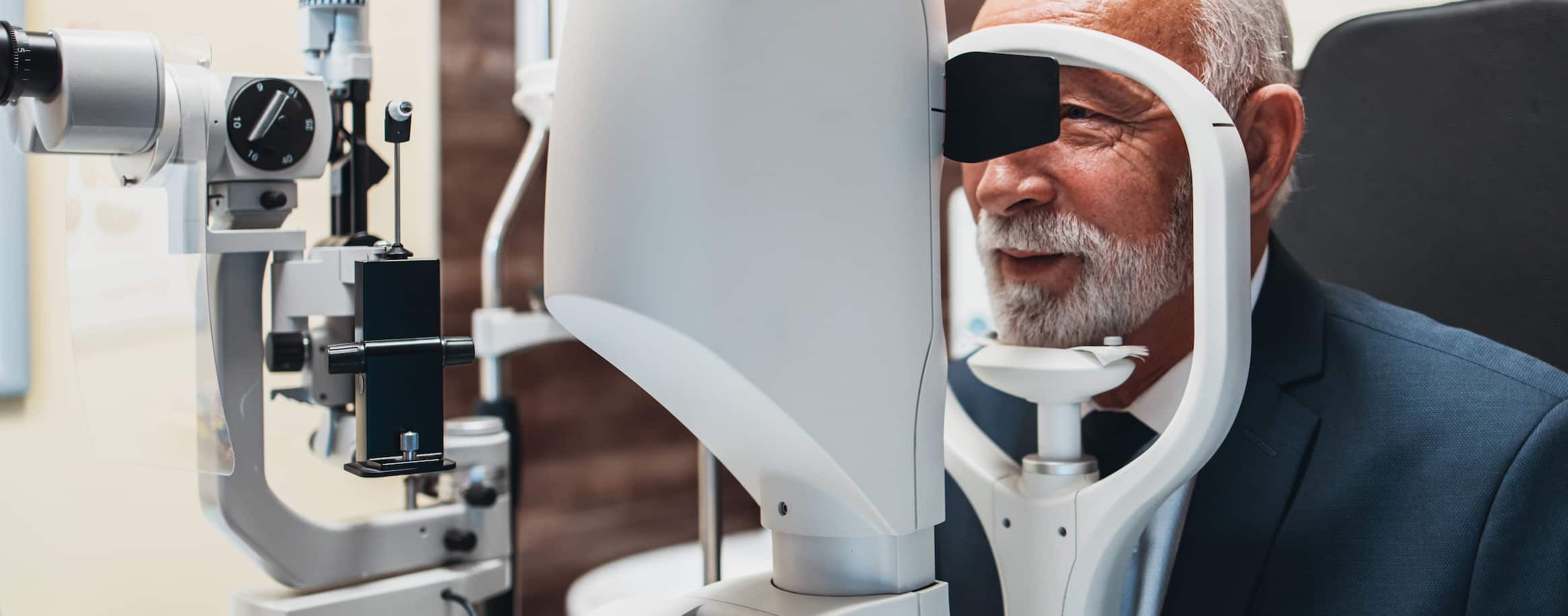Strabismus, a condition where the eyes are misaligned, affects around 4% of the U.S. population—about 13 million
Trusted Source
Strabismus
Cleveland Clinic
Go to Source
people
. Commonly referred to as crossed eyes or wandering eyes, adult strabismus can cause issues like double vision, impaired depth perception, and decreased visual clarity. Beyond visual symptoms, it can also impact quality of life, often affecting self-confidence and the ease of performing daily
Trusted Source
The psychosocial effects of adult strabismus: a review British Journal of Ophthalmology
Durnian JM, Noonan CP, Marsh IB
Go to Source
activities
. At Southern Eye Group, we are dedicated to helping adults across Mobile, the Gulf Coast, and Alabama address and manage strabismus for improved vision and quality of life.

What is Strabismus?
Strabismus, commonly known as eye misalignment, occurs when the eyes do not properly align with one another. This condition may involve one eye pointing in a different direction—either inward, outward, upward, or downward—while the other eye remains focused forward. Under typical circumstances, six muscles work together to control eye movement, allowing both eyes to aim in the same direction. However, with strabismus, one or more of these muscles struggle to maintain alignment, leading to a noticeable imbalance between the eyes.
While strabismus is most commonly diagnosed in children, it is possible for adults to develop strabismus later in life. Roughly 4% of the US population
What Causes Strabismus in Adults?
Strabismus in adult patients can develop for various reasons, often linked to other health conditions or aging-related changes. Some adults may have been born with this condition, with symptoms that either improved over time or reappeared later in life due to the natural weakening of eye muscles. Strabismus may also emerge following health issues like stroke, diabetes, or thyroid eye disease, which can disrupt the blood flow or nerve function needed for proper eye alignment. Additionally, trauma, certain neurological conditions, and past eye surgeries—such as cataract surgery or surgery for retinal detachment—can contribute to the onset of strabismus in
Trusted Source
Adult Strabismus
Yale Medicine
Go to Source
adulthood
.

Symptoms of Adult Strabismus
Adults with strabismus may experience a range of symptoms, including double vision or “visual confusion,” where objects appear misaligned. Other common signs include involuntary eye movement or wandering, squinting, tilting or turning the head to focus, and frequent eye strain or headaches. Some adults may find themselves closing one eye, especially in bright light or when viewing objects at different distances, to improve focus. Adults with strabismus may also feel weakness in the affected eye(s) or a sensation that their eye is being “pulled.” In cases where strabismus is recent, double vision is more likely; however, over time, the brain may suppress the signal from the affected eye, potentially leading to
Trusted Source
What is Adult Strabismus?
American Academy of Ophthalmology
Go to Source
amblyopia
, or “lazy eye.”

Types of Strabismus
There are several types of strabismus, each describing a specific direction in which the eye may misalign:
- Esotropia: The affected eye turns inward, toward the nose.
- Exotropia: The affected eye turns outward, away from the nose.
- Hypertropia: One eye shifts upward, moving out of alignment with the other.
- Hypotropia: One eye shifts downward, causing a vertical misalignment.
- Incyclotropia: The eye rotates slightly inward, with the top of the eye angled toward the nose.
- Excyclotropia: The eye rotates slightly outward, with the top of the eye angled toward the
Trusted Source Strabismus Kanukollu VM, Sood G Go to Source temple .
Strabismus can be constant or may occur only intermittently. When intermittent, strabismus is sometimes referred to as transient strabismus. It can also vary in which eye is affected; for some individuals, misalignment always occurs in the same eye (unilateral), while for others, it may alternate between both
Trusted Source
Strabismus
Cleveland Clinic
Go to Source
eyes
(alternating). These different types and patterns of strabismus impact vision and depth perception in unique ways, with either continuous or periodic effects on eye alignment.

Treatment for Adult Strabismus
Several treatment options are available for adults with strabismus, depending on the severity of misalignment and individual needs:
- Strabismus Surgery: For many adults, eye muscle surgery is the most effective way to correct eye misalignment. This procedure involves adjusting the eye muscles—either tightening, loosening, or repositioning them—to help the eyes align properly. Often performed as an outpatient procedure under local or general anesthesia, strabismus surgery can improve eye coordination and visual function. Some patients may require more than one surgery to achieve optimal results, but recovery typically takes only a few days.
- Prism Glasses: For those with mild double vision, prism lenses can be incorporated into eyeglasses to correct visual misalignment. These lenses work by bending light, helping the eyes align so they see a single, unified image.
Each of these treatments aims to improve eye alignment, reduce symptoms like double vision, and help enhance quality of life for adults with strabismus.
FAQs About Adult Strabismus
Am I too old for strabismus treatment?
No, strabismus treatment is effective for adults of all ages. While strabismus is often associated with childhood, many adults benefit from treatment to improve eye alignment, reduce symptoms like double vision, and enhance quality of life. Whether through surgery, specialized glasses, or other therapies, adults of any age can explore treatment options to address strabismus and achieve better visual function.
Will insurance cover strabismus surgery?
In most cases, insurance companies do cover strabismus surgery for adults, as it is considered a medically necessary, reconstructive procedure—not a cosmetic one. Strabismus can cause functional issues like double vision and eye strain, making surgery essential for improving daily life. Some insurance plans may require pre-authorization, so it’s a good idea to check with your provider to understand the specifics of your coverage. If any issues arise with approval, our team can work directly with your insurance company to clarify the need for this treatment.
What happens during strabismus surgery?
In strabismus surgery, an ophthalmologist adjusts the eye muscles to improve alignment. The procedure is typically done under local anesthesia, but some adults may choose to undergo strabismus surgery under general anesthesia. During the surgery, a small incision is made on the white part of the eye, allowing access to the targeted eye muscle. The surgeon then detaches and repositions this muscle, either loosening or tightening it to achieve proper alignment. Contrary to some myths, the entire eye does not need to be removed during strabismus surgery. Adjusting the muscle’s position changes the pull on the eye, helping it point in the correct direction.
How successful is strabismus surgery?
Strabismus surgery is generally highly successful, with most patients achieving significant improvement in eye alignment after just one procedure. However, healing varies, and in some cases, minor adjustments may be needed as the eye muscles settle into place. If the alignment shifts over time or the initial surgery only partially corrects the misalignment, additional surgery may be recommended. In cases of residual double vision, prism glasses can further enhance visual clarity and alignment.
What are the risks of strabismus surgery?
As with any surgical procedure, strabismus surgery carries certain risks. The most common ones are residual eye misalignment and temporary double vision, though in some cases, double vision may persist. More serious risks are rare but can include anesthesia-related complications, scarring on the eye’s surface, infection, eyelid drooping, bleeding, retinal detachment, and decreased vision. Individual health factors may also influence risk, and in cases where general anesthesia is a concern, surgery can often be performed under local anesthesia
Trusted Source
Adult Strabismus
American Association for Pediatric Ophthalmology and Strabismus
Go to Source
instead
.

Schedule a Consultation
If you’re experiencing symptoms of adult strabismus or have questions about treatment options, the team at Southern Eye Group is here to help. Our specialists offer personalized care to improve eye alignment and quality of life for patients across Mobile, the Gulf Coast, and throughout Alabama. Contact us today to schedule a consultation and take the first step toward better vision and renewed confidence.
1 Cleveland Clinic. Strabismus. Available: https://my.clevelandclinic.org/health/diseases/strabismus-eye-misalignment. Accessed October 29, 2024.
2 Durnian JM, Noonan CP, Marsh IB. The psychosocial effects of adult strabismus: a review British Journal of Ophthalmology 2011;95:450-453. Available: https://bjo.bmj.com/content/95/4/450. Accessed October 29, 2024.
3 Yale Medicine. Adult Strabismus. Available: https://www.yalemedicine.org/conditions/adult-strabismus. Accessed October 29, 2024.
4 American Academy of Ophthalmology. What is Adult Strabismus? Available: https://www.aao.org/eye-health/diseases/what-is-strabismus. Accessed October 29, 2024.
5 Kanukollu VM, Sood G. Strabismus. [Updated 2023 Nov 13]. In: StatPearls [Internet]. Treasure Island (FL): StatPearls Publishing; 2024 Jan-. Available from: https://www.ncbi.nlm.nih.gov/books/NBK560782/. Accessed October 29, 2024.
6 Cleveland Clinic. Strabismus. Available: https://my.clevelandclinic.org/health/diseases/strabismus-eye-misalignment. Accessed October 29, 2024.
7 American Association for Pediatric Ophthalmology and Strabismus. Adult Strabismus. Available: https://aapos.org/glossary/adult-strabismus. Accessed October 29, 2024.
The doctors at Southern Eye Group have either authored or reviewed and approved this content.
Page Updated:


